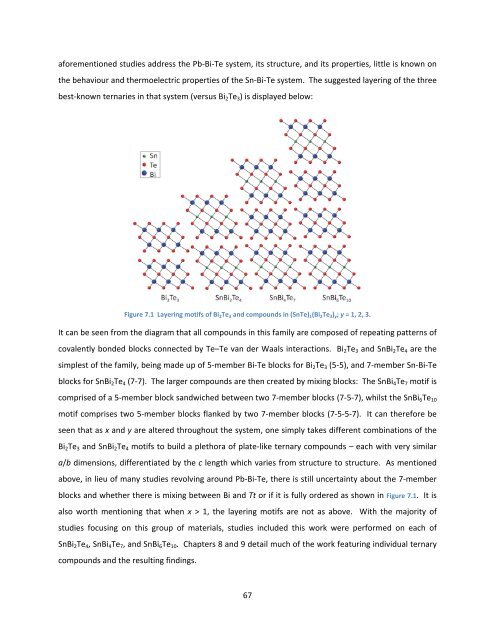Exploration and Optimization of Tellurium‐Based Thermoelectrics
Exploration and Optimization of Tellurium‐Based Thermoelectrics
Exploration and Optimization of Tellurium‐Based Thermoelectrics
Create successful ePaper yourself
Turn your PDF publications into a flip-book with our unique Google optimized e-Paper software.
aforementioned studies address the Pb‐Bi‐Te system, its structure, <strong>and</strong> its properties, little is known on<br />
the behaviour <strong>and</strong> thermoelectric properties <strong>of</strong> the Sn‐Bi‐Te system. The suggested layering <strong>of</strong> the three<br />
best‐known ternaries in that system (versus Bi2Te3) is displayed below:<br />
Figure 7.1 Layering motifs <strong>of</strong> Bi 2Te 3 <strong>and</strong> compounds in (SnTe) 1(Bi 2Te 3) y; y = 1, 2, 3.<br />
It can be seen from the diagram that all compounds in this family are composed <strong>of</strong> repeating patterns <strong>of</strong><br />
covalently bonded blocks connected by Te–Te van der Waals interactions. Bi2Te3 <strong>and</strong> SnBi2Te4 are the<br />
simplest <strong>of</strong> the family, being made up <strong>of</strong> 5‐member Bi‐Te blocks for Bi2Te3 (5‐5), <strong>and</strong> 7‐member Sn‐Bi‐Te<br />
blocks for SnBi2Te4 (7‐7). The larger compounds are then created by mixing blocks: The SnBi4Te7 motif is<br />
comprised <strong>of</strong> a 5‐member block s<strong>and</strong>wiched between two 7‐member blocks (7‐5‐7), whilst the SnBi6Te10<br />
motif comprises two 5‐member blocks flanked by two 7‐member blocks (7‐5‐5‐7). It can therefore be<br />
seen that as x <strong>and</strong> y are altered throughout the system, one simply takes different combinations <strong>of</strong> the<br />
Bi2Te3 <strong>and</strong> SnBi2Te4 motifs to build a plethora <strong>of</strong> plate‐like ternary compounds – each with very similar<br />
a/b dimensions, differentiated by the c length which varies from structure to structure. As mentioned<br />
above, in lieu <strong>of</strong> many studies revolving around Pb‐Bi‐Te, there is still uncertainty about the 7‐member<br />
blocks <strong>and</strong> whether there is mixing between Bi <strong>and</strong> Tt or if it is fully ordered as shown in Figure 7.1. It is<br />
also worth mentioning that when x > 1, the layering motifs are not as above. With the majority <strong>of</strong><br />
studies focusing on this group <strong>of</strong> materials, studies included this work were performed on each <strong>of</strong><br />
SnBi2Te4, SnBi4Te7, <strong>and</strong> SnBi6Te10. Chapters 8 <strong>and</strong> 9 detail much <strong>of</strong> the work featuring individual ternary<br />
compounds <strong>and</strong> the resulting findings.<br />
67
















